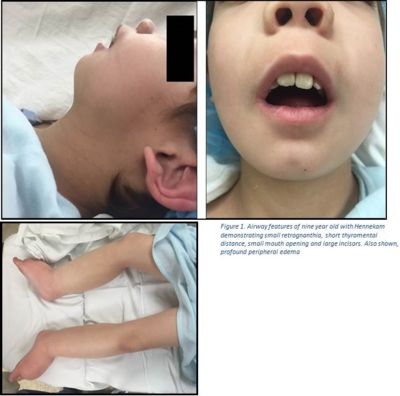2017 FSA Posters
P026: ANESTHETIC MANAGEMENT OF THE PEDIATRIC PATIENT WITH SEVERE HEREDITARY LYMPHEDEMA AND KNOWN DIFFICULT INTUBATION
Benjamin Schumacher, DO, Jacqueline Tutiven, MD; University of Miami/Jackson Memorial Hospital
Introduction: A nine-year-old boy with Hennekam syndrome presented for exam under general anesthesia and trabeculectomy secondary to glaucoma. Hennekam syndrome was first reported in 1989 with less than 50 cases described world-wide. Our patient had classic signs of Hennekam syndrome including severe peripheral edema, micrognathia, retrognathia, history of reactive airway disease and hypoalbuminemia (Figure 1). In addition, he had a known history of difficult intubation. He had a medi-port in place for frequent infusions of albumin which was utilized due to difficult IV access. We performed an inhalational induction and maintained general anesthesia via LMA. His case proceeded uneventfully and he was discharged from PACU to home without incident. After review of the literature, there remains little information regarding anesthetic implications for this unique syndrome. The goal of this article is to assemble the wide variety of phenotypes that may have an impact on the anesthesiologist and make recommendations for anesthetic management.

Methods: This is a case report of a rare genetic condition known as Hennekam syndrome. The case was performed by the authors. We performed a literature review in order to assemble the most information published about the condition. Anatomic and physiologic features important to the practice of anesthesia were then assembled in a systems-based report. Recommendation were drawn from personal experience with this patient as well as from knowledge about the syndrome.
Results: We found that there are four predictors of difficult airway common in patients with Hennekam syndrome which include micrognathia, high arched palate, retrognathia and short thyromental distance. These patients also have an abundance of soft tissue swelling in the airway. There is a wide range of cardiac anomalies reported some of which required surgical repair. A combination of pleural effusions, pericardial effusions or ascites was present in nearly every patient reported. They also have profound peripheral edema and hypoproteinemia affecting IV access, fluid management and possibly anesthetic pharmacokinetics. Seizures occur in about one third of patients with Hennekam.
Discussion: Hennekam syndrome is a now well-described inheritable condition with little information regarding anesthetic implications. There are at least four independent predictors of difficult airway common to these patients which are micrognathia, retrognathia, high arched palate and short thyromental distance. Other factors that may further complicate airway management include extensive soft tissue swelling, teeth anomalies, large teeth and poor patient cooperation. Airway management should be approached with caution. If endotracheal intubation is necessitated by the procedure, rescue equipment, i.e. LMA, should be available in appropriate sizes to avoid worsening pharyngeal edema. There should also be video laryngoscopy or fiberoptic equipment in the room. Cardiac anomalies are common and lesions may remain asymptomatic due to a child with poor functional ability and generalized edema. A screening echocardiogram is recommended prior to elective surgery. Seizure medication should be continued perioperatively and careful monitoring post-operatively. We demonstrated that patients with Hennekam syndrome can be safely sent home following general anesthesia when they meet appropriate discharge criteria.
